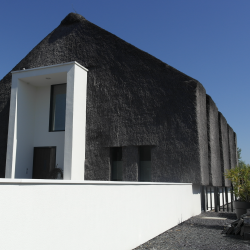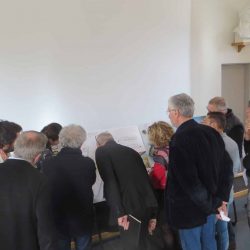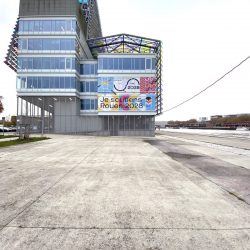They defended their doctorates at ATE...
- Carole Lemans - The potential of contemporary reed architecture
- Raphaël Rattier -Designing with timber today: A contribution to the renewal of contemporary architecture
- Damien Renault - Training local elected officials in architecture, or architecture as political education
- Cristina Sanchez-Algarra - Urban recipes for the European Capital of Culture label: from desired city to reinvented territory
Carole Lemans
The potential of contemporary reed architecture

Date of defense: December 2, 2022
Thesis supervisor: François FLEURY
Laboratory: Architecture Territoire Environnement (ENSA Normandie) / ED 556 HSRT
Funding: French Ministry of Culture, BRAUP
Date of 1st thesis registration: 2019
Jury members
Arthur HELLOUIN DE MENIBUS, Docteur, Examinateur
Ali LIMAM, Professeur INSA Lyon, Rapporteur
Jean-Baptiste MARIE, Professeur ENSA Clermont-Ferrand, Examinateur
Soline NIVET, Professeur ENSA Paris Malaquais, Rapporteure
Thesis summary
This doctoral thesis in architecture examines the potential of the "reed" resource in contemporary architecture, taking into account the issues linked to the sector and its players, the constructive and performance dimensions, and the possible registers of expression.
First, the potential of contemporary thatch architecture is studied in relation to the distance taken with traditional thatch roofing forms and techniques. This is followed by a theoretical assessment of the material's limits and potential today, based in particular on observation of the Dutch context. These elements are then confronted with a set of contemporary achievements, apprehended on the one hand according to the morphological analysis of an extensive corpus, and on the other hand through a smaller number of case studies and the discourses that accompany them. The assumption that contemporary thatch architecture is ecological is only partially correct. The realization of its potential actually requires certain conditions in order to be ecologically effective.
The second part of this thesis is deliberately forward-looking, and proposes to investigate through experimentation the potential of reed architecture, and no longer thatch: can we make this material more ecological? It presents three project situations seeking to innovate with reed, two of which are specifically developed within the framework of the thesis. With a different level of reading on these experiments, we observe the influence of the level of knowledge, concerning reed and the thatching technique, on the performance of the design process.
The thesis observes and documents over a hundred buildings ranging from the 2000s to 2021. The field of study, mainly focused on France, also extends to Europe and, to a lesser extent, Japan, where the climate is more or less similar to that of France. As the current French thatching industry is poorly documented, field investigation through learning the practice of thatching is an important part of the knowledge contribution, leading today to the constitution of a network of reed actors.
Raphaël Rattier
Designing with timber today: A contribution to the renewal of contemporary architecture

Defense date: October 14, 2024
Thesis supervisor: François FLEURY
Laboratory: Architecture Territoire Environnement (ENSA Normandie) / ED 556 HSRT
Funding: French Ministry of Culture, BRAUP / PNRMCB
Date of 1st thesis registration: 2019
Jury members
Erwan HAMARD rapporteur, ingénieur de recherche HDRn Université Gustave Eiffel, GPEM
Nathalie TORNAY rapporteur, maîtresse de conférence HDR, ENSA Toulouse, LRA
Valéry DIDELON examiner, professeur, ENSA Normandie, ATE
Antonella MASTRORILLI examiner, professeur, ENSAP Lille, LACTH
Steve GOODHEW examiner, professor, School of Art, Design and Architecture University of Plymouth
Estelle MORLÉ examiner, maîtresse de conférence, ENSA Lyon, EVS-LAURE
François STREIFF examiner, architecte-conseil, PNR des marais du Cotentin et du Bessin
Thesis summary
This thesis looks at recent cob architecture in France and the UK, and how designers are adapting their practices to bring cob into their projects. It highlights the technique's potential not only to renew contemporary architecture, but also to transform the design process.
Since the 1990s, one of the most popular raw-earth construction techniques, bauge, has been re-emerging in contemporary architecture, but its forms and construction methods differ from those of traditional architecture. On the other hand, in spite of this revival, logs are struggling to make a real impact on the architectural landscape, and architects are frustrated to hear of "obstacles" to the use of a technique that is out of step with conventional construction. This research proposes a new reading of the available knowledge likely to inform the design and prescription of bauges, while questioning what this knowledge produces in terms of practices and singular architectures.
The corpus we've assembled - inscribed knowledge, testimonials from industry players, and recent buildings - is examined from three angles related to logs: that of phenomena, that of imaginaries, and that of practices. Cross-observations highlight the fragmentation of knowledge required to assess the technique's potential, a renewal of aesthetics in discourse and architectural production, capable of transforming the imaginary of timber more generally, and finally, a reappropriation of the power of the project manager in his conventional action, with a transformation of his relationship to the construction and to those involved on the site. These insights can help us to question certain paradigms of architectural design, at a time when the ecological and social challenges of construction are calling us to reconsider our model of society.
This thesis therefore offers a critical and situated catalog of knowledge on architecture and construction in logs, addressed to those who wish to design with this technique.
Damien Renault
Training local elected officials in architecture, or architecture as political education

Date of defense: October 5, 2023
Thesis supervisor: Caroline MANIAQUE
Laboratory: Architecture Territoire Environnement (ENSA Normandie) / ED 556 HSRT
Funding: French Ministry of Culture, BRAUP
Date of 1st thesis registration: 2018
Jury members
Véronique BIAU, Architecte-urbaniste en chef de l'État, ENSA de Paris-La-Villette, LET-LAVUE, rapporteur
Pierre CAYE, Directeur de recherche, ENS Ulm, Centre Jean-Pépin, rapporteur
Jean-Charles CHABANNE, Professeur des Universités, ENS Lyon, Institut français de l'éducation, ECP, LIRDEF, examiner
Arnaud DUTHEIL, Architect, examiner
Marc FROCHAUX, Architect, examiner
Thesis summary
The proposal also responds to the initial political demand, presenting itself as a tool for improving (or didactizing) current architectural advisory and mediation practices, and for professionalizing advisors and mediators.
Finally, going beyond this demand, the survey allows us to consider architectural advisory, mediation and training as a means of political education for elected representatives.
Cristina Sanchez-Algarra
Urban recipes for the European Capital of Culture label: from desired city to reinvented territory

Defense date: December 12, 2024
Thesis director: Bruno Proth
Thesis co-supervisor: Dominique Dehais
Attaching laboratory: Architecture Territory Environment (ENSA Normandie) / ED 556 HSRT
Funding: Region via the RIN scheme 50% and Metropole of Rouen Normandie
Date of 1st thesis registration: 2021
Jury members
VLaurent DEVISME, rapporteur - Professeur - Nantes Université
Cristina MAZZONI, rapporteur - Professeur - ENSA Paris-Belleville
Marc DUMONT, examiner - Professeur - Université de Lille
Françoise LUCCHINI, examiner - Maîtresse de Conférences HDR - Université de Rouen Normandie
Elise PALOMARES, examiner - Professeur - Université de Rouen Normandie
Elsa VIVANT, examiner - Professeur - École des Ponts Paristech
Thesis summary
This thesis analyzes the construction of French cities' bids for the European Capital of Culture label for the year 2028, up to the designation of Bourges in December 2023 after a heightened national competition. These bids are studied as initiatives capable of constructing narratives establishing the guidelines of urban production, this label being a tool exalting the prospective image of a city. The research explores the way in which the preparation of a cultural project of international scope enables us to reflect on the contemporary conditions of the process of making cities and their spaces, whether materially or socially conceived.
Complementing the urban studies focusing on the post-event legacy, and through the close-up analysis of nine candidate cities, and more specifically the finalists Bourges, Clermont-Ferrand, Montpellier and Rouen, we explore the strategies for elaborating an allegedly federative discourse that nevertheless addresses a variety of audiences with divergent expectations. In this respect, the label is an edifying catalyst for analysis, insofar as we are also interested in the possible instrumentalization of this narrative which, by drawing on the symbolic power of art and culture to underpin certain political agendas, would contribute to pacifying tensions without overcoming partisan, territorial and social cleavages. Our study focuses on two subjects in particular: territorial construction and the urban strategy for hosting the event.
In a context marked by the interweaving of crises - territorial, economic and environmental - we question the paradigms perceptible in the bidding documents and the positioning of candidate cities in relation to contemporary urban issues. To do so, we focus on projects that are either disconnected from, or linked to, existing public policies and urban images and references, with the aim of verifying whether the concept of the "successful city", so dear to European discourse, translates into a single political, social, economic and urban response.